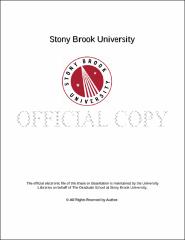| dc.identifier.uri | http://hdl.handle.net/1951/60260 | |
| dc.identifier.uri | http://hdl.handle.net/11401/71523 | |
| dc.description.sponsorship | This work is sponsored by the Stony Brook University Graduate School in compliance with the requirements for completion of degree. | en_US |
| dc.format | Monograph | |
| dc.format.medium | Electronic Resource | en_US |
| dc.language.iso | en_US | |
| dc.publisher | The Graduate School, Stony Brook University: Stony Brook, NY. | |
| dc.type | Dissertation | |
| dcterms.abstract | Transposable elements (TE) are indispensible to understand the evolution of genes and genomes in almost all organisms. DNA transposable elements, class 2 elements, have become a source of material for coordination of eukaryotic gene regulatory systems and for chromosomal reconstruction. In particular, mobility of DNA transposons has been used for insertional mutagenesis to generate new alleles in plants and animals. The well-known MuDR/Mu system in maize has been adopted for saturation mutagenesis and allowed for the production of myriads of novel mutant alleles in the Maize-Targeted-Mutagenesis (MTM) collection. However, the potential value of this collection has not been properly realized due to the lack of mapped Mu-insertion alleles. Here, I show that the position of newly transmitted germinal insertions in the genome can be identified on a large scale via next-generation sequencing technology coupled with a GenomeWalker PCR strategy. I found that more than 100 Mu elements per plant transpose mostly into hypomethylated genic regions. In a parallel study, I show that a 1.8-Mb chromosomal inversion, mediated by a novel Mu-like element, is responsible for the classical Tunicate1 mutation in maize. This is because the inversion causes a fusion between Zmm19 MADS box gene 5' regulatory region with the 3' end of another gene, GRMZM2G006297. Interestingly, I found a subsequent regional duplication after the chromosomal rearrangement. Sequencing of the duplication break point suggested that CACTA and MITE transposons, which are another classes of DNA transposons in maize, may be involved in this regional duplication, which results in dosage-dependent upregulation of both genes. Taken together, transposon-mediated chromosomal rearrangement and subsequent regional duplication at Tu1 can influence not only rearrangement of a chromosomal segment but also transcriptional regulatory networks of adjacent genes. | |
| dcterms.available | 2013-05-24T16:38:19Z | |
| dcterms.available | 2015-04-24T14:47:48Z | |
| dcterms.contributor | Jackson, David | en_US |
| dcterms.contributor | Martienssen, Robert | en_US |
| dcterms.contributor | Milles, Alea | en_US |
| dcterms.contributor | Brutnell, Thomas | en_US |
| dcterms.contributor | Citovsky, Vitaly | en_US |
| dcterms.creator | Han, Jong-Jin | |
| dcterms.dateAccepted | 2013-05-24T16:38:19Z | |
| dcterms.dateAccepted | 2015-04-24T14:47:48Z | |
| dcterms.dateSubmitted | 2013-05-24T16:38:19Z | |
| dcterms.dateSubmitted | 2015-04-24T14:47:48Z | |
| dcterms.description | Department of Biochemistry and Cell Biology | en_US |
| dcterms.extent | 156 pg. | en_US |
| dcterms.format | Application/PDF | en_US |
| dcterms.format | Monograph | |
| dcterms.identifier | http://hdl.handle.net/1951/60260 | |
| dcterms.identifier | http://hdl.handle.net/11401/71523 | |
| dcterms.issued | 2012-12-01 | |
| dcterms.language | en_US | |
| dcterms.provenance | Made available in DSpace on 2013-05-24T16:38:19Z (GMT). No. of bitstreams: 1
StonyBrookUniversityETDPageEmbargo_20130517082608_116839.pdf: 41286 bytes, checksum: 425a156df10bbe213bfdf4d175026e82 (MD5)
Previous issue date: 1 | en |
| dcterms.provenance | Made available in DSpace on 2015-04-24T14:47:48Z (GMT). No. of bitstreams: 3
StonyBrookUniversityETDPageEmbargo_20130517082608_116839.pdf.jpg: 1934 bytes, checksum: c116f0e1e7be19420106a88253e31f2e (MD5)
StonyBrookUniversityETDPageEmbargo_20130517082608_116839.pdf.txt: 336 bytes, checksum: 84c0f8f99f2b4ae66b3cc3ade09ad2e9 (MD5)
StonyBrookUniversityETDPageEmbargo_20130517082608_116839.pdf: 41286 bytes, checksum: 425a156df10bbe213bfdf4d175026e82 (MD5)
Previous issue date: 1 | en |
| dcterms.publisher | The Graduate School, Stony Brook University: Stony Brook, NY. | |
| dcterms.subject | allelic diversity, chromosomal rearrangement, DNA transposon, transposable element, Tunicate1, zea mays | |
| dcterms.subject | Molecular biology--Cellular biology--Genetics | |
| dcterms.title | The Impact of DNA Transposable Elements on Allelic Diversity in Maize | |
| dcterms.type | Dissertation | |

